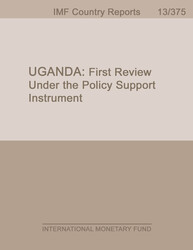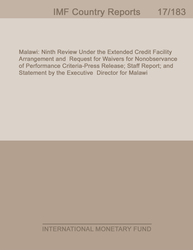
Uganda: First Review Under The Policy Support Instrument
ISCR/13/375
KEY ISSUESGrowth has continued to recover from the 2011/12 low. In an environment ofdeclining inflation—recently halted by a drought-driven food price shock—the fiscalstimulus has been successful in driving economic activity, and a planned program ofinfrastructure investment is expected to boost growth further.Monetary policy was appropriately tightened to abate the impact of the price shockon core inflation. Consolidating its credibility as an inflation-targeting central bank, theBank of Uganda (BoU) raised the policy rate in reaction to the shock, and subsequentlysignaled a neutral monetary stance until the updated inflation forecast adjusts to the5 percent medium-term target. Exchange rate flexibility continued to support the regime.Construction of two large hydropower projects is expected to address Uganda'selectricity deficit. The economy would absorb these investments with limited impact oninflation and the exchange rate. Nonetheless, efficiency and transparency in managingthe projects are crucial to mitigating potential fiscal risks.The external accounts remain sustainable. The current account deficit declined mainlyowing to a temporary slowdown of foreign direct investment (FDI)-related imports.International reserves would remain at a comfortable level despite the high importcomponent of the hydropower projects. External debt will remain at low risk of distressnotwithstanding the non-concessional borrowing (NCB) requirements to finance theprojects.The fiscal stance has remained broadly consistent with the program, but spendingpressures need to be resisted. With output closer to potential and the recent inflationpickup, expenditure needs to adhere to the budget. Although there is space for raisingthe domestic debt-to-GDP ratio somewhat this year, it needs to start declining thereafterbecause domestic debt service accounts for a large share of government revenue.With satisfactory program performance, staff supports completing the first PSIreview and increasing the ceiling on NCB. Quantitative assessment criteria (QAC)were met and structural benchmarks partially observed. Operation of a treasury singleaccount started, public accounting systems were improved, and the central bank wasrecapitalized. Progress on increasing tax revenues and reducing arrears, however, arekey remaining challenges.
Publication date: December 2013
ISBN: 9781475522754
$18.00
Add to Cart by clicking price of the language and format you'd like to purchase
Available Languages and Formats
| English |
Prices in red indicate formats that are not yet available but are forthcoming.
Topics covered in this book
This title contains information about the following subjects.
Click on a subject if you would like to see other titles with the same subjects.
Also of interest
Summary
Copyright © 2010 - 2024
Powered by:
AIDC



